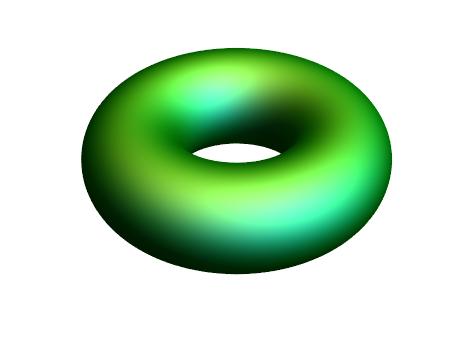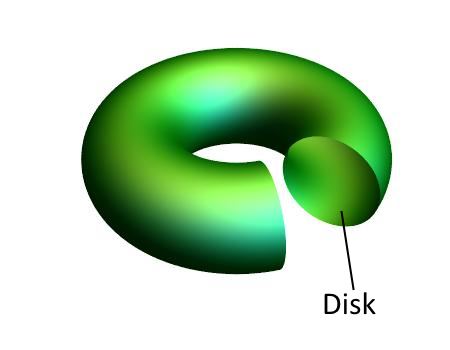In the last post, while getting hyperbolic, we have met the Lie group SU(1,1) – the group of ![]() complex matrices
complex matrices ![]() of determinant one,
of determinant one, ![]() and such that
and such that
(1) ![]()
where
(2) ![]()
and star ![]() is Hermitian conjugated matrix to
is Hermitian conjugated matrix to ![]()
It was our first meeting here with SU(1,1), and there was no enough time to decide whether we want to make friends with this group or not. Today we will look at SU(1,1) closer, in particular at her shape. I think we will like her … She has, as we will see below, the shape of the inside of a solid torus, donut-like shape:

How do we get this donut? One method is to visit a backery, another method is by doing some little algebra. We will choose the second method. In fact, we are going to get not only the shape of the group itself, but also the shape of the disk that the group is acting on! It will be the cross-section of the torus:

Let us take a matrix ![]() from SU(1,1). It is a complex
from SU(1,1). It is a complex ![]() matrix, so let us write it as
matrix, so let us write it as
(3) ![]()
(4) ![]()
On the other hand we have
(5) ![]()
and so from the determining Eq. (1) we must have
(i) 
Eq. (iv) is just a complex conjugation of (iii), so it does not bring us any new information. The whole information is contained in the first three equations.
From the first two equations we deduce that, since ![]() and
and ![]() therefore
therefore ![]() and
and ![]() are non-zero. From Eq. (iii), dividing by non-zero
are non-zero. From Eq. (iii), dividing by non-zero ![]() we get
we get
(6) ![]()
which we substitute into Eq. (4)
![]()
or, multiplying both sides with ![]()
![]()
Then, using Eq. (ii), we get ![]() , thus
, thus
(7) ![]()
Therefore, from Eq. (6), we get ![]() or
or
(8) ![]()
So, we obtain that every matrix ![]() of SU(1,1) is of the form
of SU(1,1) is of the form
(9) ![]()
(10) ![]()
Conversely, every matrix of this form is in SU(1,1).
Now, we will determine the shape of our beauty.
(11) ![]()
where ![]() is the uniquely defined phase,
is the uniquely defined phase, ![]()
(12) ![]()
Then, using Eq. (10)
(13) ![]()
Thus ![]() is in the interior of the unit disk in the complex plane.
is in the interior of the unit disk in the complex plane.
Conversely, given ![]() and
and ![]() with
with ![]() we can determine uniquely
we can determine uniquely ![]() and
and ![]() From Eq. (13) we set
From Eq. (13) we set
(14) ![]()
then
Finally, using Eq. (12), we set
(15) ![]()
Summarizing, the shape of SU(1,1) is that of the Cartesian product of the circle parametrized by ![]()
![]() and of the interior of the unit disk, parametrized by complex numbers
and of the interior of the unit disk, parametrized by complex numbers ![]() with
with ![]() That is the interior of the solid torus, that is the donut without its skin.
That is the interior of the solid torus, that is the donut without its skin.

Pretty and tasty. Not necessarily healthy, though….






“in particular at her shape. I think we will like her … She has,”
Sexist, true lover, or Pole?
Perhaps all three.
Thanks. I realized that WP QuickLatex is not handling arrays of equations the same way as my standard Latex does.
Thanks for all the errata. Fixed.
Well I have missed something here.
I assume the torus is generated by rotating about an axis through the origin.
1)If |z|<1, is that not a disk centred about the orign?
2)I guess the disk could be centred about an offset point and then it would be |z|<1 wrt that point, but what defines that point?
That is the question of convention and convenience. Bjab addressed this question in http://arkadiusz-jadczyk.eu/blog/2017/04/circular-orbits-su11-2/#comment-888
Ok, but, I know am being slow here.It is an important basic point of this new section. Having difficulty translating the pure maths into computer algebra. Could you post some of you code so I can see what you are doing with the complex numbers?
I am trying to pay attention to the basic fundamentals and the pratical implimentation of them. Else I will never understand.
Sure, but again, please, be specific. Tell me precisely what you would like to see in code? It can be many pieces of the code, whatever you would like to see, but I need to know what exactly.
I have tones of code. Some of it is good, some of it is a failure. Before posting anything I have to do some cleaning first.
Ok, The partial torus with the orbits shown at the start of the next post.http://arkadiusz-jadczyk.eu/blog/2017/04/su11-action-disk/
Ok. I will prepare something.
The orbits are described in http://arkadiusz-jadczyk.eu/blog/2017/04/circular-orbits-su11/
They are circles going all around torus. In Maple use functions
x(u,v,r):=(1+r*cos(u))*cos(v);
y(u,v,r):=(1+r*cos(u))*sin(v); z(u,v,r):=r*sin(u);
Parameter v goues around the disk. Parameters r,u define a point on the disk, section of the torus.
To draw incomplete torus I tried
plot3d([x(u, v, 1), y(u, v, 1), z(u, v, 1)], u = 0 .. 2*Pi, v = (1/4)*Pi .. 2*Pi, scaling = constrained, transparency = .2, style = patchnogrid, lightmodel = light4, shading = zhue);
But then you have to rotate it to look nice. Probably light should be also adjusted. I am not good with playing with Maple.
The trajectories are curves with r and u fixed and v going from 0 to 2 Pi.
In my plot I used the sequence r=0,0.4,0.8
and u from 0 to 2Pi step Pi/4.
Let me know if the above info was enough for you to get the result.
Thank you,That works.Experimenting I changed torus to.
x(u, v, r):= (2+r*cos(u))*cos(v); y(u, v, r):= (2+r*cos(u))*sin(v) ; z(u, v, r):= r*sin(u)
Just to make a hole in the middle. Is that valid in this context. Plots fine.
Torus := plot3d([x(u, v, 1), y(u, v, 1), z(u, v, 1)], u = 0 .. 2*Pi, v = (1/4)*Pi .. 2*Pi, scaling = constrained, transparency = .2, style = patchnogrid, lightmodel = light2, shading = zhue):
For the paths
r := [0, .4, .8];
n := 1:
for i to 3 do
for j from 0 to 8 do
p[n] := plot3d([x((1/4)*j*Pi, v, r[i]), y((1/4)*j*Pi, v, r[i]), z((1/4)*j*Pi, v, r[i])], v = 0 .. 2*Pi, scaling = constrained);
n := n+1
end do
end do;
display(Torus, seq(p[h], h = 1 .. n-1))
Result http://imgur.com/a/PwNvz
I like your choice of colour scheme type. I am learning more and more.
Yes, that is fine. You did a good job.